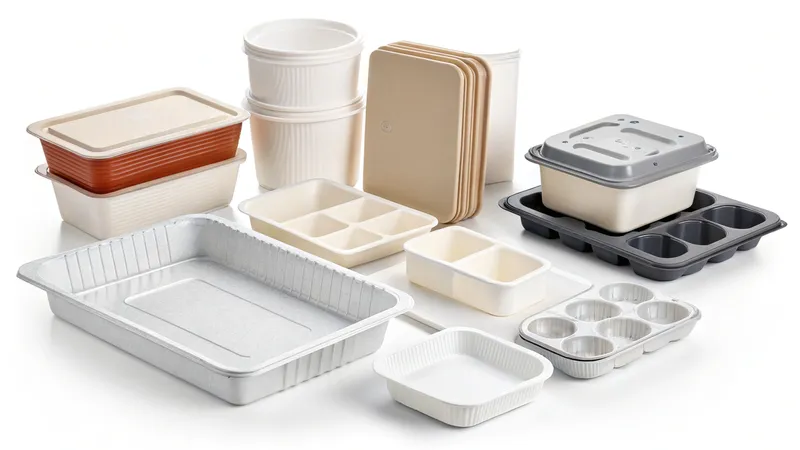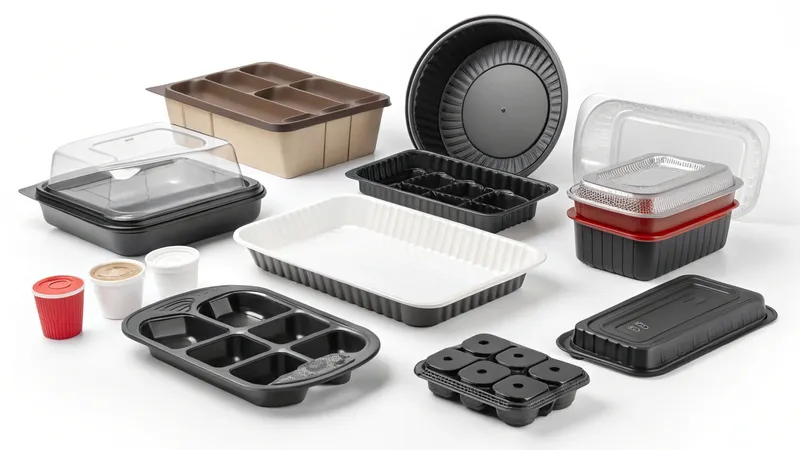
Vacuum forming is a versatile manufacturing process that transforms heated plastic sheets into a wide range of products using vacuum pressure. This technique is widely adopted across industries for its ability to create lightweight, durable products with simple to moderately complex shapes, all while keeping costs low for small to medium production runs.
Vacuum forming creates فعالة من حيث التكلفة1, lightweight plastic products2 with simple to moderately complex shapes, ideal for low to medium production volumes in industries like packaging, automotive, and signage.
Understanding what vacuum forming can achieve is key to leveraging its benefits for your next project. This article explores the product features made possible by التشكيل بالتفريغ3, its applications, advantages, limitations, and how it stacks up against other manufacturing methods like injection molding.
Vacuum forming is ideal for producing large, lightweight parts.صحيح
The process allows for the creation of sizable components with minimal material usage, reducing weight and cost.
يمكن للتشكيل بالتفريغ أن يحقق نفس المستوى من التفاصيل مثل التشكيل بالحقن.خطأ
While vacuum forming is versatile, it cannot match the precision and complexity achievable with injection molding.
- 1. What Are the Key Product Features Achievable with Vacuum Forming?
- 2. What Materials Are Commonly Used in Vacuum Forming?
- 3. What Are the Applications of Vacuum Forming?
- 4. What Are the Advantages and Limitations of Vacuum Forming?
- 5. How Does Vacuum Forming Compare to Injection Molding?
- 6. الخاتمة
What Are the Key Product Features Achievable with Vacuum Forming?
Vacuum forming shapes heated plastic sheets over a mold using vacuum pressure, enabling the creation of a variety of product features that cater to diverse needs.

Vacuum forming achieves simple to moderately complex shapes, large parts, lightweight products, and cost-effective solutions for low to medium production volumes.
| الميزة | الوصف | الملاحظات |
|---|---|---|
| Simple to Moderately Complex Shapes | Suitable for gentle curves and shallow depths | Not ideal for intricate designs |
| Large Parts4 | Can produce sizable components like car dashboards | Limited by sheet size |
| منتجات خفيفة الوزن5 | Uses thin plastic sheets, reducing weight | Beneficial for weight-sensitive applications |
| Cost-Effective6 | Low tooling costs, ideal for small to medium runs | Molds are cheaper than injection molding |
Simple to Moderately Complex Shapes
Vacuum forming shines when creating products with gentle curves and shallow depths, such as trays, enclosures, and packaging. It’s less suited for highly intricate designs with sharp angles or deep draws, but it handles a wide range of practical shapes effectively. For instance, vacuum forming is a go-to method for producing blister packs that protect and display products.

Large Parts
A standout feature of vacuum forming is its ability to produce large parts, like automotive dashboards or retail signage. The process can accommodate plastic sheets several meters wide, making it a cost-effective choice for oversized components that might be challenging or expensive to create with other methods.
منتجات خفيفة الوزن
By using thin plastic sheets, vacuum forming naturally produces lightweight products—a major advantage in industries like transportation or portable equipment. This feature reduces material costs and improves efficiency, such as in aerospace applications where every ounce matters.
Cost-Effective for Low to Medium Volumes
Vacuum forming’s low tooling costs make it an economical option for small to medium production runs. Molds can be crafted from affordable materials like wood or 3D-printed plastics for prototypes, or aluminum for slightly larger batches, offering flexibility without the hefty upfront investment required by processes like injection molding.
Vacuum forming is suitable for high-volume production.خطأ
While cost-effective for low to medium volumes, vacuum forming is less efficient for high-volume production compared to injection molding.
Vacuum forming can produce parts with uniform wall thickness.خطأ
The stretching of the plastic sheet can lead to variations in wall thickness, especially in deeper draws.
What Materials Are Commonly Used in Vacuum Forming?
The material chosen for vacuum forming plays a critical role in determining the final product’s properties, from strength to appearance.

Common materials in vacuum forming include HIPS, ABS, PETG, and Acrylic, each offering unique attributes like impact resistance, durability, and transparency.
| المواد | الخصائص | التطبيقات النموذجية |
|---|---|---|
| البوليسترين عالي التأثير (HIPS)7 | Low cost, impact-resistant, easy to form | التعبئة والتغليف واللافتات |
| أكريلونيتريل بوتادين ستايرين (ABS)8 | Rigid, durable, chemically resistant | قطع غيار السيارات، العبوات |
| بولي إيثيلين تيريفثالات الجلايكول (PETG)9 | Transparent, ductile, food-safe | Medical devices, food packaging |
| أكريليك (PMMA) | High optical clarity, weather-resistant | Signage, protective covers |
البوليسترين عالي التأثير (HIPS)
HIPS is a budget-friendly, easy-to-form material with decent impact resistance, making it a favorite for packaging and signage. While not as durable as some alternatives, it’s perfect for cost-sensitive projects.
أكريلونيتريل بوتادين ستايرين (ABS)
ABS brings rigidity and chemical resistance to the table, ideal for tough applications like automotive parts or protective enclosures. Its versatility suits both indoor and outdoor use.

بولي إيثيلين تيريفثالات الجلايكول (PETG)
PETG offers transparency and flexibility, plus it’s food-safe, making it a top pick for medical device covers and food packaging where visibility and safety are priorities.
أكريليك (PMMA)
Acrylic stands out with its optical clarity and weather resistance, perfect for outdoor signage or stylish protective covers. It can also be colored or tinted for added design flair.
Material selection in vacuum forming affects the product's strength and appearance.صحيح
Different materials offer varying levels of durability, transparency, and finish, directly impacting the final product.
What Are the Applications of Vacuum Forming?
Vacuum forming’s versatility makes it a staple in multiple industries, producing practical and visually appealing products.
Vacuum forming is commonly used in packaging, automotive, signage, and protective covers due to its cost efficiency and adaptability.

التعبئة والتغليف
From blister packs to clamshells, vacuum forming is a packaging powerhouse, offering clear, durable solutions for food, electronics, and medical devices that protect while showcasing the contents.
السيارات
In the automotive world, vacuum forming crafts lightweight interior components like dashboards and door panels, enhancing vehicle efficiency and aesthetics without breaking the bank.

اللافتات
Large, vibrant signs for retail and advertising often come from vacuum forming, especially when made with materials like Acrylic that withstand the elements while grabbing attention.
Protective Covers
Vacuum forming produces lightweight yet sturdy covers for machinery, equipment, and vehicles, providing essential protection without adding unnecessary weight.
يُعد التشكيل بالتفريغ مثاليًا للنماذج الأولية.صحيح
Its low tooling costs and quick turnaround make vacuum forming an excellent choice for creating prototypes.
What Are the Advantages and Limitations of Vacuum Forming?
A balanced look at vacuum forming’s strengths and weaknesses helps determine if it’s the right fit for your needs.
Vacuum forming offers low tooling costs, quick turnaround, and versatility but is limited by its inability to handle complex designs and variable wall thickness.

المزايا
-
انخفاض تكاليف الأدوات10: Molds are affordable and quick to produce, ideal for small runs or prototypes.
-
Quick Turnaround11: The process is fast, speeding up production and testing cycles.
-
تعدد الاستخدامات: It works with various materials and shapes, adapting to diverse applications.

القيود
-
Limited Complexity12: Intricate designs or deep draws can lead to issues like webbing or tearing.
-
Variable Wall Thickness: Stretching the plastic can cause uneven thickness, especially in deeper parts.
-
Material Restrictions: Only thermoplastics are compatible, limiting some use cases.
Vacuum forming requires expensive molds.خطأ
Molds for vacuum forming are relatively inexpensive compared to those used in injection molding, especially for prototypes.
How Does Vacuum Forming Compare to Injection Molding?
Vacuum forming and injection molding are both valuable, but they serve different purposes based on cost, precision, and scale.

Vacuum forming offers lower initial costs and faster turnaround for low to medium volumes, while injection molding provides higher precision and suits high-volume production.
| أسبكت | التشكيل بالتفريغ | القولبة بالحقن |
|---|---|---|
| التكلفة الأولية | Low (molds ~£1000-£1500) | High (complex tooling) |
| حجم الإنتاج13 | Best for low to medium runs | Ideal for high volumes |
| التعقيد | Simple to moderately complex shapes | Suitable for complex, high-precision parts |
| Turnaround Time | Fast, good for prototypes | Slower due to tooling setup |
| الاتساق المادي | May have variable wall thickness | Consistent wall thickness |
التكلفة
Vacuum forming’s low mold costs shine for smaller runs, while injection molding’s higher initial investment pays off in large-scale production with lower per-part costs.
الدقة
Injection molding wins for complex, precise parts, whereas vacuum forming is better for simpler designs where slight variations are acceptable.

حجم الإنتاج
Vacuum forming excels in low to medium volumes, while injection molding dominates high-volume runs with its efficiency and consistency.
Vacuum forming is faster than injection molding for prototyping.صحيح
The simpler mold-making process and quicker setup make vacuum forming ideal for rapid prototyping.
الخاتمة
Vacuum forming is a dynamic process that delivers lightweight, cost-effective products with simple to moderately complex shapes. Its ability to craft large parts quickly and economically makes it a go-to for industries like packaging, automotive, and signage. However, its limitations—like struggles with intricate designs or uniform thickness—mean it’s not a one-size-fits-all solution.
By weighing vacuum forming’s features against alternatives like injection molding, you can choose the best approach for your project. Whether you’re prototyping or producing a small batch, vacuum forming offers a practical, efficient path forward.
-
Learn about the cost benefits of vacuum forming and how it can save money in your manufacturing projects. ↩
-
Discover the process of creating lightweight plastic products and how vacuum forming plays a crucial role in their production. ↩
-
Explore the advantages of vacuum forming to understand how it can enhance your production efficiency and product quality. ↩
-
Learn about the benefits of vacuum forming for large parts and how it can optimize production processes. ↩
-
Discover the significance of lightweight products in reducing costs and enhancing performance in various industries. ↩
-
Explore this link to understand how cost-effective manufacturing can save money and improve production efficiency. ↩
-
Explore the advantages of HIPS in vacuum forming, including its cost-effectiveness and impact resistance, to enhance your project decisions. ↩
-
Learn why ABS is favored in automotive applications for its durability and chemical resistance, crucial for high-performance parts. ↩
-
Discover the food-safe properties of PETG and its transparency, making it ideal for medical and food packaging solutions. ↩
-
Understanding low tooling costs can help you assess the economic advantages of vacuum forming for your projects. ↩
-
Exploring quick turnaround benefits can reveal how vacuum forming accelerates your production timelines. ↩
-
Learning about the challenges of limited complexity can help you decide if vacuum forming suits your design needs. ↩
-
Discover the key factors affecting Production Volume to optimize your manufacturing strategy and improve efficiency. ↩








